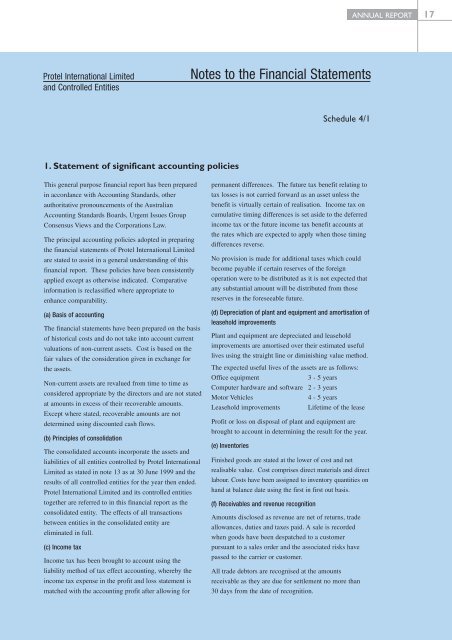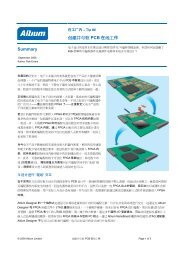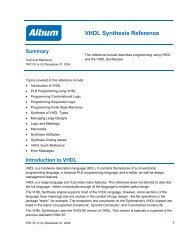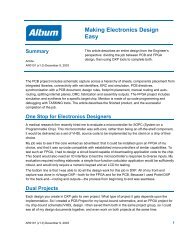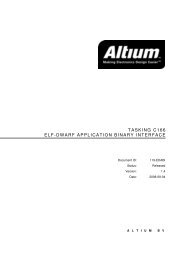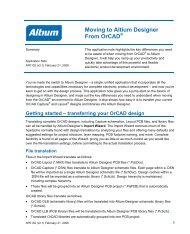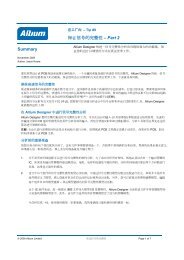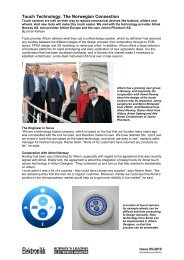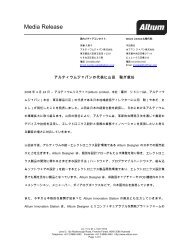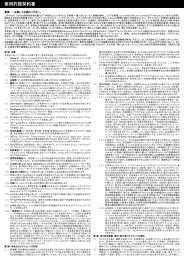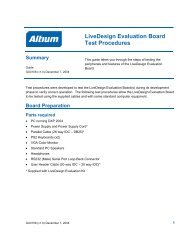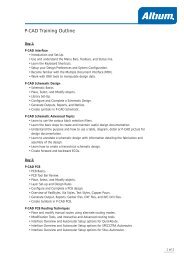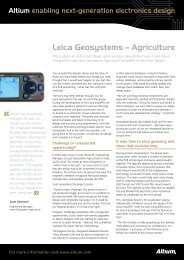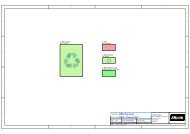1999 Annual Report - Altium
1999 Annual Report - Altium
1999 Annual Report - Altium
Create successful ePaper yourself
Turn your PDF publications into a flip-book with our unique Google optimized e-Paper software.
Protel International Limited<br />
and Controlled Entities<br />
1. Statement of significant accounting policies<br />
This general purpose financial report has been prepared<br />
in accordance with Accounting Standards, other<br />
authoritative pronouncements of the Australian<br />
Accounting Standards Boards, Urgent Issues Group<br />
Consensus Views and the Corporations Law.<br />
The principal accounting policies adopted in preparing<br />
the financial statements of Protel International Limited<br />
are stated to assist in a general understanding of this<br />
financial report. These policies have been consistently<br />
applied except as otherwise indicated. Comparative<br />
information is reclassified where appropriate to<br />
enhance comparability.<br />
(a) Basis of accounting<br />
The financial statements have been prepared on the basis<br />
of historical costs and do not take into account current<br />
valuations of non-current assets. Cost is based on the<br />
fair values of the consideration given in exchange for<br />
the assets.<br />
Non-current assets are revalued from time to time as<br />
considered appropriate by the directors and are not stated<br />
at amounts in excess of their recoverable amounts.<br />
Except where stated, recoverable amounts are not<br />
determined using discounted cash flows.<br />
(b) Principles of consolidation<br />
The consolidated accounts incorporate the assets and<br />
liabilities of all entities controlled by Protel International<br />
Limited as stated in note 13 as at 30 June <strong>1999</strong> and the<br />
results of all controlled entities for the year then ended.<br />
Protel International Limited and its controlled entities<br />
together are referred to in this financial report as the<br />
consolidated entity. The effects of all transactions<br />
between entities in the consolidated entity are<br />
eliminated in full.<br />
(c) Income tax<br />
Income tax has been brought to account using the<br />
liability method of tax effect accounting, whereby the<br />
income tax expense in the profit and loss statement is<br />
matched with the accounting profit after allowing for<br />
Notes to the Financial Statements<br />
permanent differences. The future tax benefit relating to<br />
tax losses is not carried forward as an asset unless the<br />
benefit is virtually certain of realisation. Income tax on<br />
cumulative timing differences is set aside to the deferred<br />
income tax or the future income tax benefit accounts at<br />
the rates which are expected to apply when those timing<br />
differences reverse.<br />
No provision is made for additional taxes which could<br />
become payable if certain reserves of the foreign<br />
operation were to be distributed as it is not expected that<br />
any substantial amount will be distributed from those<br />
reserves in the foreseeable future.<br />
(d) Depreciation of plant and equipment and amortisation of<br />
leasehold improvements<br />
Plant and equipment are depreciated and leasehold<br />
improvements are amortised over their estimated useful<br />
lives using the straight line or diminishing value method.<br />
The expected useful lives of the assets are as follows:<br />
Office equipment 3 - 5 years<br />
Computer hardware and software 2 - 3 years<br />
Motor Vehicles 4 - 5 years<br />
Leasehold improvements Lifetime of the lease<br />
Profit or loss on disposal of plant and equipment are<br />
brought to account in determining the result for the year.<br />
(e) Inventories<br />
Finished goods are stated at the lower of cost and net<br />
realisable value. Cost comprises direct materials and direct<br />
labour. Costs have been assigned to inventory quantities on<br />
hand at balance date using the first in first out basis.<br />
(f) Receivables and revenue recognition<br />
Schedule 4/1<br />
Amounts disclosed as revenue are net of returns, trade<br />
allowances, duties and taxes paid. A sale is recorded<br />
when goods have been despatched to a customer<br />
pursuant to a sales order and the associated risks have<br />
passed to the carrier or customer.<br />
All trade debtors are recognised at the amounts<br />
receivable as they are due for settlement no more than<br />
30 days from the date of recognition.<br />
ANNUAL REPORT 17


